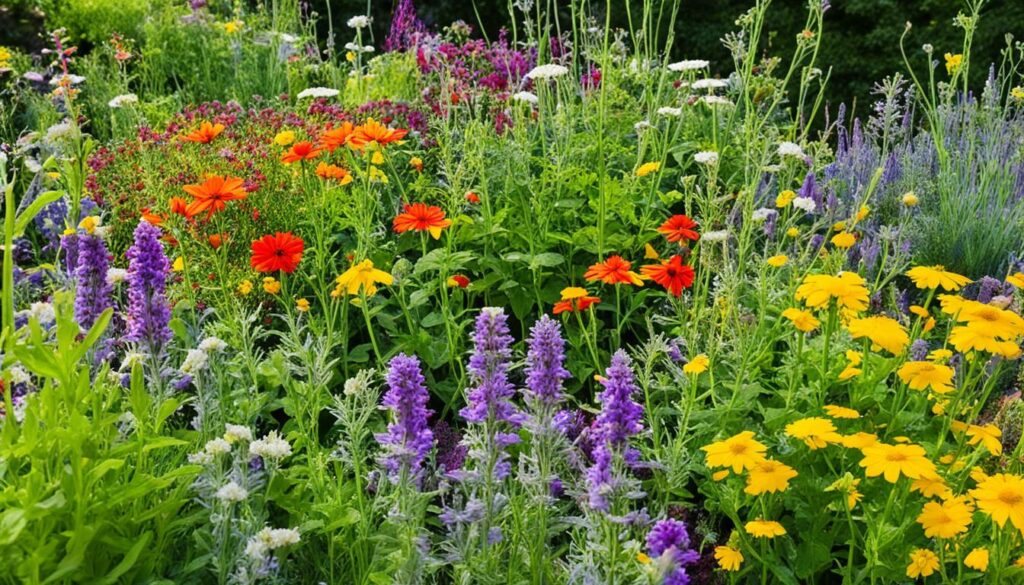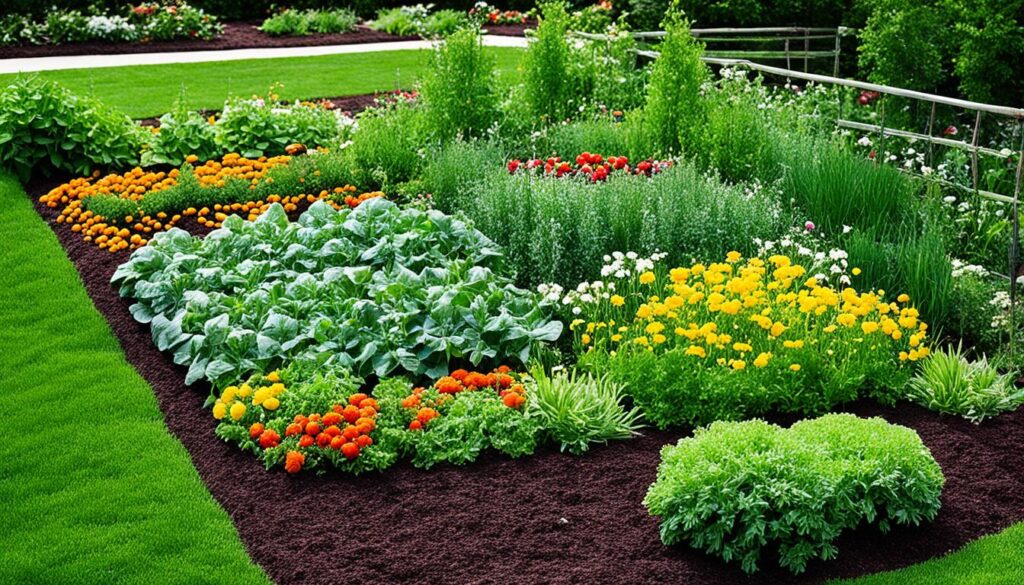Companion Planting Guide: Boost Your Garden’s Health
Imagine a garden full of life where each plant helps the others grow. What if you could make a garden where plants work together to fight pests, make the soil better, and use space well? The answer is companion planting. By placing plants together wisely, you can make your garden better and get more from your work.
Companion planting is an old gardening trick that uses the natural benefits of different plants together. By having a garden with many kinds of plants, you make a system that helps everyone. This way, you get rid of pests, make the soil better, and make your garden more productive.
Key Takeaways
- Discover the secrets of companion planting for a thriving, sustainable garden
- Learn how to leverage natural plant relationships for improved pest control and productivity
- Explore the science behind companion planting and its benefits for your garden
- Maximize your growing space through strategic planting techniques
- Enhance soil health and fertility with companion planting practices
Are you ready to make your garden better and have a lush, full garden? Start with companion planting and turn your backyard into a green, self-sustaining place.
What is Companion Planting?
Companion planting means growing different plants together to help each other out. This method creates a diverse garden that benefits from natural connections between plants, insects, and soil. It helps your garden stay healthy and productive by fighting pests, improving soil, and reducing weeds.
Definition and Benefits of Companion Planting
Companion planting is all about plants helping each other out. Some plants protect against pests, while others make the soil better or keep weeds down. This method offers many advantages, like natural pest control, boosting soil fertility, and weed suppression. It leads to increased yields and makes gardening more sustainable and successful.
The Science Behind Companion Planting
Studies have shown how companion planting works, revealing the complex relationships between plants and insects. Some plants can keep pests away with their chemical defenses or by attracting beneficial insects. For instance, nasturtiums near fruit trees can keep moths away, and radishes with pumpkins can protect against squash bugs. This science highlights the intricate connections in a diverse garden.
“By growing communities of plants that are known to support each other, you can save a lot of time and potential heartache.”
Saving Space with Companion Planting
If you have a small garden, companion planting can change the game. By interplanting crops and using container gardening, you can use every inch of space. You’ll grow many plants and enjoy how they work well together.
Interplanting Techniques for Small Gardens
Succession planting is key for saving space. Plant quick-growing crops like lettuce or radishes with slower ones like tomatoes. When you pick the early crops, the others have room to grow. This saves space and helps with weed management and soil health.
Maximizing Space with Container Gardening
Container gardening is great for small spaces. Use big planters or raised beds for a “salad garden” or “pizza garden”. This lets you grow many plants in a small area. You’ll enjoy the benefits of companion planting too.
Whether you have a tiny balcony or a small yard, companion planting can make your garden better. It helps you grow a space-saving garden that gives you lots of food.
Improving Soil Health through Companion Planting
Improving your garden’s soil health is key to a thriving garden. Companion planting is a natural way to do this. By pairing plants together, you use their unique roots and nutrient-cycling to make a better garden ecosystem.
Utilizing Different Root Structures
Companion planting uses the different root systems of plants to improve soil health. Mixing deep-rooted and shallow-rooted plants makes the most of soil resources. Deep-rooted plants like tomatoes and carrots get nutrients from deep in the soil. Shallow-rooted plants like lettuce grow well in the top layers.
This mix helps aerate the soil and keeps nutrients from running out. It’s a smart way to make your garden more resilient.
Incorporating Legumes for Nitrogen Fixation
Legumes like peas, beans, and clover are great for soil health. They can take nitrogen from the air and add it to the soil for other plants. This means you use fewer synthetic fertilizers and keep your garden healthy.
You can eat the legumes or use them as cover crops. Their leaves and roots add nitrogen to the soil. This is a smart way to make your garden better for the environment and for you.
Using different plants together can really help your garden’s soil. Whether you focus on roots or nitrogen, these methods make for a healthy, easy garden. It’s good for the planet and good for you.
Mutual Support through Companion Planting
The three sisters method is a classic example of how plants help each other grow. It involves planting corn, beans, and squash together. This technique has been used by indigenous communities in Mesoamerica for hundreds of years. It shows how plants can work together to improve their growth.
In this system, the corn acts as a support for the beans to climb on. The beans then fix nitrogen in the soil, which helps the corn and squash grow better. The squash uses its big leaves to keep weeds away and protect the corn from pests like raccoons.
“The three sisters model is a testament to the wisdom of traditional planting techniques and the power of mutual support in the garden.”
The three sisters method is part of the milpa farming way. It combines corn, beans, and squash with other crops and animals. This approach creates a diverse and strong farming system. By using physical support and nutrient cycling, gardeners can make the most of their land and grow a healthy, self-supporting garden.
Companion Planting for Insect Management
Gardeners looking to control pests naturally can use companion planting. This method attracts beneficial insects and pollinators. It also uses trap cropping and repellent plants to keep away insect pests.
Attracting Beneficial Insects and Pollinators
Adding nectar-rich plants to your garden draws in helpful insects. Syrphid flies, which eat aphids, are a great example. These bugs lay their eggs near aphids, controlling pests naturally.
- Include flowers like cosmos, zinnias, and sunflowers to attract syrphid flies and pollinators.
- Grow brassicas such as arugula, mustard, and napa cabbage for aphid predators.
- Choose cucurbit plants like blue hubbard squash to trap cucumber beetles.
Trap Cropping and Repellent Plants
Companion planting can also trap pests away from your main crops with trap cropping. “Spicier” brassica varieties can draw flea beetles away from your main plants.
Plants with strong smells and defenses, like marigolds, nasturtiums, and garlic, can repel insects from your garden.
“Companion planting is a powerful tool for managing garden pests organically and promoting a thriving, balanced ecosystem in your backyard oasis.”
Companion Planting with Herbs and Flowers
Herbs and flowers are key in companion planting. Many herbs, like basil, dill, and sage, have strong smells that keep insects away. Flowers draw in helpful insects with their nectar and pollen.
Adding herbs and flowers to your garden helps fight pests and attract pollinators. This makes your garden healthier and more balanced. Companion planting with herbs and flowers offers many benefits, including:
- Natural Pest Control: Some herbs’ smells confuse garden pests, reducing the need for chemicals.
- Pollinator Attraction: Flowers draw bees and butterflies, which are key for plant health and growth.
- Beneficial Insect Habitats: Flowers and herbs are homes for insects that eat garden pests.
When planning your companion planting with herbs and flowers, think about what your vegetables need and the traits of different plants. A diverse garden helps control pests and pollination, leading to a better harvest.

“Companion planting with herbs and flowers is a simple yet powerful way to create a more resilient and productive vegetable garden. By harnessing the natural pest-fighting and pollinator-attracting properties of these plants, you can cultivate a thriving, balanced ecosystem that benefits both you and the environment.”
Choosing the Right Herbs and Flowers
When picking herbs and flowers for your companion planting, think about what your vegetables need and the plants’ unique traits. Some top picks for companion planting with herbs are:
- Basil: Keeps aphids away and protects tomatoes.
- Dill: Draws in ladybugs and lacewings that eat pests.
- Marigolds: Deters nematodes and other pests in the soil.
For companion planting with flowers, plant a mix of flowers to attract many pollinators and beneficial insects, such as:
- Sunflowers: Offer nectar and pollen for bees and other pollinators.
- Nasturtiums: Repel aphids and other pests from vegetables.
- Cosmos: Attract ladybugs and lacewings.
| Herb/Flower | Pest Repelling | Pollinator Attraction | Beneficial Insect Habitats |
|---|---|---|---|
| Basil | ✓ | ||
| Dill | ✓ | ||
| Marigolds | ✓ | ||
| Sunflowers | ✓ | ||
| Nasturtiums | ✓ | ||
| Cosmos | ✓ |
Proven Companion Planting Combinations
Companion planting is a great way to make your garden healthier and more productive. By pairing certain plants together, you can fight off pests and make the soil better. Let’s look at some top combinations to try in your garden.
Brassicas: Cabbage, Broccoli, and Kale
Brassicas like cabbage, broccoli, and kale do well together. The “spicier” ones, like arugula, mustard, and napa cabbage, can lure pests away from the main crops. Sage, thyme, and nasturtium also help keep pests like diamondback moth and cabbage worms off.
Tomatoes and Basil
Basil and tomatoes are a great pair. Basil keeps thrips and moths away from tomatoes. It also brings in bees, which helps pollinate the tomatoes and makes them taste better.
Squash and Pumpkins
Squash and pumpkins benefit a lot from companion planting. Blue hubbard squash, for example, draws in pests away from other squash. Nasturtiums near squash and pumpkins also keep pests down. Plus, having many flowers helps pollinators, which are key for these plants.
“Companion planting is a time-honored technique that can help create a more resilient and productive garden.”
Companion Planting Chart
Companion planting isn’t a hard science, but a chart can help gardeners. These charts list veggies, herbs, and flowers with their best friends and foes. By using a chart and noting what works for you, you can find the best plant pairs for your garden.
A good chart shows how different plants work well together. These pairs can boost soil health, draw in good bugs, and keep pests away. Knowing about these plant friendships can make your garden better and stronger.
| Plant | Beneficial Companions | Antagonistic Companions |
|---|---|---|
| Tomatoes | Basil, Marigolds, Nasturtiums | Potatoes, Fennel, Corn |
| Carrots | Radishes, Chives, Rosemary | Dill, Parsnips |
| Cucumbers | Marigolds, Nasturtiums, Radishes | Potatoes, Aromatic Herbs |
| Lettuce | Carrots, Radishes, Beets | Parsley, Celery |
This chart is just a starting point. The best plant pairs can change with your local weather, soil, and more. Try different combos and keep track of what works best for your garden.

“Companion planting is like a dance between plants, where each one plays a unique role in supporting the others.”
Getting Started with Companion Planting
Starting your companion planting journey is a fun step towards a better garden. First, plan your garden layout well. Think about how long each plant takes to grow, what nutrients it needs, and its size when choosing which plants to grow together. Interplanting, where you plant different crops close to each other, helps use space well and boosts garden productivity, especially in small gardens.
Container gardening is a great way to try out companion planting too. You can make “theme” gardens, like a pizza or salad garden, in one big container. This lets you enjoy the benefits of companion planting even if you have little outdoor space.
Planning Your Garden Layout
Here are some tips for planning your garden layout:
- Put plants with similar growth rates and habits together to avoid competition for resources.
- Pair tall, sun-loving plants with shorter, shade-tolerant ones to make the most of vertical space.
- Think about what each crop needs in terms of nutrients and arrange them to help each other out.
Record-Keeping and Experimentation
Companion planting isn’t a hard science, and what works for one garden might not work for another. It’s key to keep detailed records of your experiments. Note which plant combinations worked and which didn’t. Over time, this will help you adjust your companion planting to fit your garden’s unique conditions.
Don’t hesitate to try new plant pairings and learn from them – the more you experiment, the better you’ll get at using companion planting. With patience and a readiness to adapt, you’ll find the best combinations to make your garden healthier and more productive.
Conclusion
Companion planting is a key to a successful, sustainable garden. By pairing plants that help each other, you can use space better, improve soil, control pests, and boost your harvest. It works well in small gardens or big plots, creating a balanced ecosystem.
Start your gardening adventure by trying new plant combinations. Find the best ones for your garden’s needs. Companion planting not only increases your harvest but also helps the planet.
Discover the secrets of companion planting to make your garden better. With creativity and respect for nature, you can grow a garden that feeds your plants and your soul. Begin your journey and watch your garden grow with the magic of companion planting.
FAQ
What is companion planting?
What are the benefits of companion planting?
How does companion planting work?
How can companion planting help with space-saving in the garden?
How does companion planting improve soil health?
Can companion planting help with pest management?
What are some proven companion planting combinations?
How do I get started with companion planting?
Source Links
- https://www.almanac.com/companion-planting-guide-vegetables – Companion Planting Chart and Guide for Vegetable Gardens
- https://extension.wvu.edu/lawn-gardening-pests/gardening/garden-management/companion-planting – Extension | Companion Planting
- https://extension.umn.edu/planting-and-growing-guides/companion-planting-home-gardens – Companion planting in home gardens
- 10 Must-Have Blooms for Your 2025 Garden
- The Health Advantages of Gardening You Need to Know
- How to Create a Small Vegetable Garden Layout Plan: A Beginner’s Guide
- DIY Garden Projects for Small Spaces: Upcycling Ideas to Maximize Your Garden
- Watering Techniques for Small Gardens: Ensuring Your Plants Thrive
- Small Border Plants for Landscaping: Adding Beauty and Functionality to Your Garden
- Year-Round Small Space Gardening: Seasonal Planting Tips for Maximum Harvest
- Essential Tools for Small-Space Gardening: What You Really Need
- The Ultimate Guide to Container Vegetables: What to Grow in Small Spaces
- Budget-Friendly Gardening: How to Create a Thriving Garden on a Tight Budget
- How to Optimize Sunlight in Small Gardens: Tips for Better Plant Growth
- DIY Vertical Planters: Creative Ideas for Small Space Gardening
- Companion Planting for Small Vegetable Gardens: Boost Growth and Deter Pests
- Container Gardening Essentials: Choosing the Right Pots, Soil, and Plants
- Vertical Gardening Techniques: Maximizing Your Small Space with Climbers and Vines
- How to Build a Raised Bed Garden in a Small Backyard: Step-by-Step Guide
- The Best Vegetables for Small-Space Gardens: High-Yield Varieties You Need to Grow
- Smart Vegetable Garden Layouts for Small Spaces: Maximizing Your Green Thumb in Compact Areas
- 40. Best Practices for Managing a Sustainable Garden Year-Round
- Building a Wildlife Pond for Biodiversity
- Advanced Techniques in Sustainable Gardening
- How to Create a No-Till Garden
- The Mental Health Benefits of Gardening
- Using Technology to Enhance Sustainable Gardening
- Getting Certified Organic: Steps and Benefits

Leave a Reply